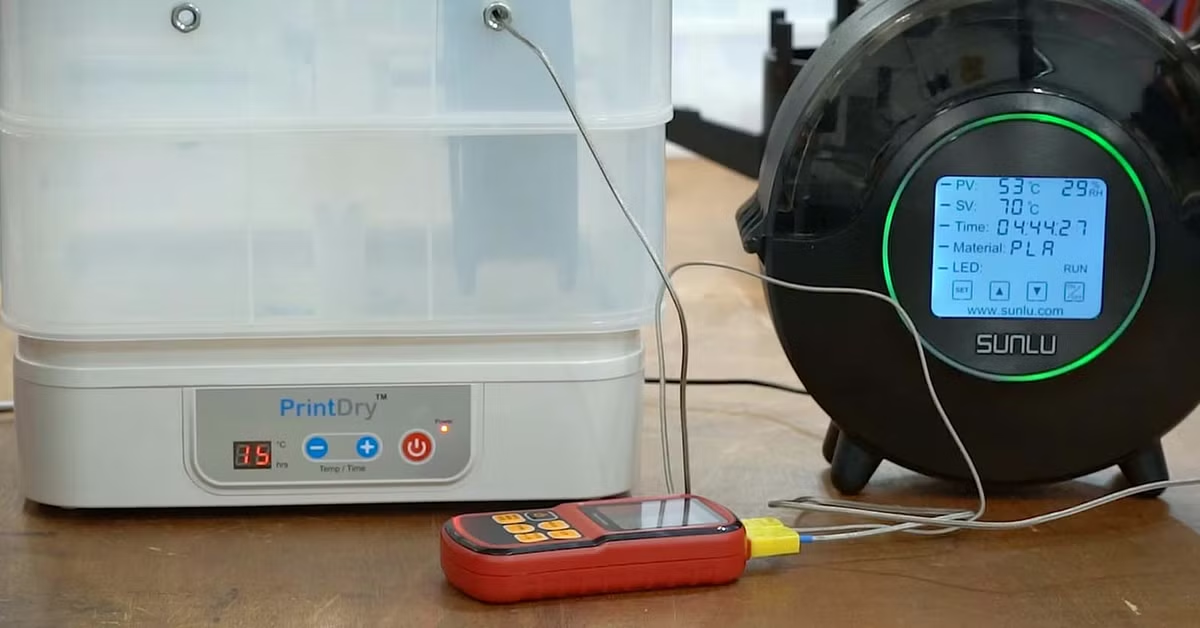As a 3D printer enthusiast, everyone knows one golden rule: your 3D prints are as good as your filaments. It doesn’t matter if you bought the latest high-end printer or even invested in premium filaments. If your filaments aren’t stored and dried properly, the quality will suffer, and all your money, time, and other mental investments will be wasted.
This is where the importance of a filament dryer comes in. These devices remove moisture from filaments, but at the same time, if the dryer is cheap with a quality that suffers, your 3D prints will suffer too.
This article explores why low-quality dryers are a risk, how they destroy expensive filaments, and what you can do to avoid filaments’ destruction.
The Role of Moisture for Filaments
Filaments like PLA, ABS, PETG, and Nylon are hygroscopic. This means they can absorb moisture from the air. When there are normal room conditions and moisture nearby, these filaments will start sucking it, and within a few hours, the water molecules will start to absorb on the surface.
So, here are some issues that moisture can cause, including,
- Bubbling or hissing during extrusion.
- Weak, fragile, or warped prints after the print has been made.
- Reduce layer adhesion, which can make parts structurally unsound.
- Reduces the filament’s overall shelf life.
Hence, drying filaments is the only way to ensure that the prints are of high quality, especially when working with expensive specialty filaments such as Nylon, Carbon Fiber, or PEEK. These premium materials can be significantly more expensive, and improper drying can waste both your time and money.
Why People Buy Cheap Filament Dryers
As 3D printing continues to grow, the market is now flooded with inexpensive dryers. Many new hobbyists see the appeal and could become a quick solution, but it comes with a big cost. Here are some of the reasons why people buy cheap filament dryers today:
- Cheap filament dryers are affordable upfront, as you’re often paying half the price compared to high-quality filament brands.
- They promise the same results, including fast drying, temperature control, and all filaments supported.
- They are quite convenient, featuring simple displays, lightweight designs, and even basic heating chambers.
However, the budget-friendly dryer often cuts corners where it matters the most—factors such as temperature irregularity, inadequate safety features, and poor airflow design. So, let’s talk about how cheap dryers destroy expensive filaments quickly.
How Cheap Dryers Destroy Expensive Filaments
- Inconsistent Heating
The biggest problem comes from inconsistent heating. High-quality filaments require precise drying temperatures. For example, if we have Nylon, it would need 70–80°C to print ideally, while PLA should be below 50 °C.
That is exactly where the issue comes in. Cheap dryers often lack stable temperature control, causing temperature fluctuations. This results in things like overheating the filaments.
Let’s say you’re printing with PLA. It will mostly overheat PLA, making it soft or deformed. Then, you might encounter that Nylon could be underheated, leaving it moist and useless.
Sometimes, the spools would be warped, especially if the plastic reels themselves got overheated. This ruins the 3D printing experience while costing you money.
- Poor Airflow Design
When you dry a filament, most people think it’s heat. This isn’t true. Proper drying is more about the mix of heat and circulating warm air evenly around the filament spool. Moreover, quality dryers use engineered airflow systems to ensure moisture escapes efficiently.
Cheaper models have lots of issues, including heat only leaving from the bottom, leaving the upper layers still damp. The next issue is a lack of ventilation, which causes the trapped steam to reabsorb into the filament.
If there’s one big problem with the issue with cheap filament, it’s going to be the uneven drying. This causes the part of the spool to be usable while the other one is ruined. The uncovered treatment caused by poor airflow is something that leads to print inconsistencies, destroying your filaments and prints.
- Plastic Degradation
Excessive or poorly regulated heat doesn’t just damage one print, but it can permanently degrade the filament’s overall structure. Prolonged exposure to a low-quality dryer can cause issues like:
- Microcracks in PLA or PETG.
- Brittleness and oxidation in Nylon.
- Lastly, color fading can also be a huge issue in specialty films.
Now, please imagine. What if you spend $100 on rolls of your favorite filament, only to have them destroyed due to their poor quality in no time? That would be a complete disaster and a waste of time and money.
- No Safety
Cheap dryers often skip essential safety features, such as auto shut-off or thermal cutoffs. Not only is this a hazard for your filament, but it also poses a risk to your home in general. Most of the time, you will increase the risk of filaments being baked far longer than intended, ruining the overall print.
Leaving filaments overnight can cause the premium spool to become an unusable mess. If the dryer continues overheating, it can melt the spool itself. Things like short circuits could happen, meaning that safety is a huge issue with cheap filaments.
This is why you should consider a dryer like the FilaPartner E1, which features enhanced safety features and provides multiple chambers for drying different spools simultaneously.
Final Verdict
Cutting corners when buying a filament dryer could be a painful experience in the long term. It ends up costing you more than it saves you, which is why you should never opt for cheaper filaments with lower quality and components.
If you’re looking to buy the best 3D printing accessories, check out Chitu Systems.







